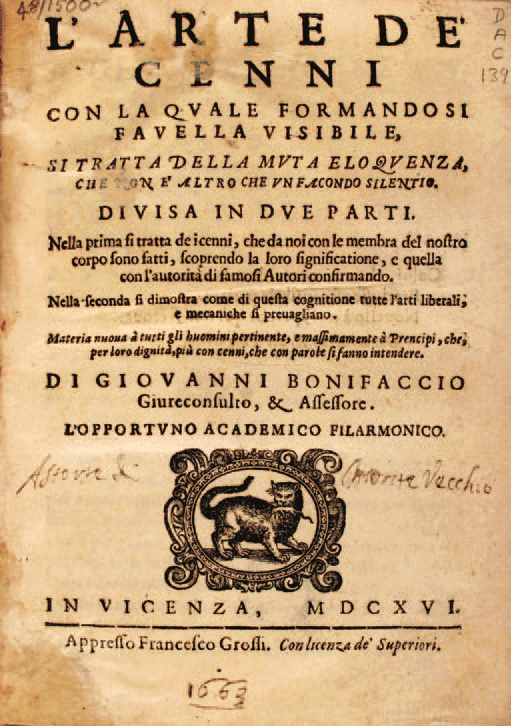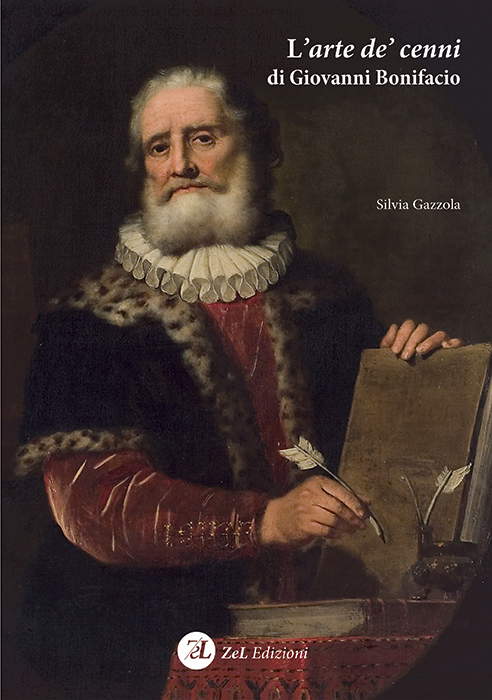A (non-pocket) guide to understanding ancient gestures
It happens not infrequently that extraordinary works of art are found in full view of everyone in a church or museum or public building and that suddenly from the condition of anonymity or underestimation in which they had remained encapsulated for centuries they are recognized as such, jumping to the headlines and becoming, in time, cornerstones of an artist, a current, a period.
The same thing can happen with books. All it takes is for its author to write at the wrong time or with the wrong publisher or with the wrong name, and a capital text can remain forgotten for centuries in a few or very few libraries around the world. This is what happened to Giovanni Bonifacio’s Artede cenni, published in Vicenza in 1616 for leditore Francesco Grossi. A text virtually unknown today.
Who was Giovanni Bonifacio? Born in Rovigo in 1547, he graduated in law in Padua in 1573 and practiced in his hometown. He composed numerous legal works, although his name is particularly linked to a history of the city of Treviso, traced from its origins to 1591. He held public offices in Bergamo, Feltre, Padua, Verona, Brescia, and Vicenza and was a member of various Academies: from that of the Solleciti (from 1588), Venetian (from 1592), Fecondi (from 1604) and Filarmonici (from 1614), to which he dedicated Larte de cenni. The gestural problematic also fascinated him because of his love of theater: in fact, he was the author of pastoral, comic, tragicomic and tragic fables. In deep connection with such theatrical interests, but also with literary and artistic ones, therefore, l’Artede cenni was born, in which he tabulates hundreds and hundreds of bodily gestures, in a complete manner and in a sequence that goes, literally, from head to toe. The author’s aim is a comprehensive and profound understanding of man, going back from the signals of the body to the motions of the soul and thus attempting to trace the reasons for the various forms of expression.
 |
| John Boniface, The Art of Hints (1616; London, Warburg Institute). |
Scholars of the stature of Benedetto Croce and Giovanni Pozzi set their eyes on the uniqueness and richness of this encyclopedic text (which in the 1616 edition amounted to 624 pages), but without the chain reactions that usually ensue after such authoritative attention. Really very few and fragmentary historical-critical studies have been devoted to the volume and its prolific author, for whom one can refer to the dense entry written by a still young Gino Benzoni in the twelfth volume of the Dizionario biografico degli italiani, of 1970 (for some time now also available online).
I came across this text when, as a recent graduate, I was wondering about the meaning of some strange gestures depicted in painting, which I had not been able to explain through the tools offered by modern historiography. I only had to leaf through it for a while and was astounded. With an unrelenting, and objectively somewhat paranoid systematicity, the author squared the sense or, for the most part, the many senses - to be attributed, say, to pulling others’ ears, or showing one’s breasts, or even scratching one’s belly One thinks that in the chapter devoted to eyelashes he, with an approach like an ophthalmologist psychologist, relentlessly analyzes eyelashes raised, eyelashes lowered, squeezing the eyelash, eyelashes around ready, linarcar le cilia, eyelash jumping, lashes shaved, mutar il ciglio, un mover di ciglia, putting the hand over the eyelash, the disturbed eyelash, the gloomy eyelash, and nubiloso, laguzzare le ciglia! He did not, however, simply explain these and many other motions from his point of view, but brought to support his interpretations timely literary precedents ranging from the Bible and the Greek and Latin classics to the authors of his time (up to Giambattista Marino). In time I became aware that a few art historians had occasionally resorted to consulting such a text: but these were random sniffs, white flies, almost invisible exceptions compared to the volume’s resounding potential.
Thus, when in 1994 at the Ca Foscari University of Venice an international conference was organized to celebrate the fourth centenary of Jacopo Tintoretto’s birth, I proposed a contribution in which the investigation of the gestural expressiveness consciously flaunted by the artist would be investigated also and above all - in the light of the indications obtainable from the Art ofHints. Among other things, I had realized that at the end of his life Jacopo Tintoretto must have been in personal contact with Bonifacio, both of them turning out to be members of the Second Venetian Academy (the Rodigino in fact mentions him in a letter of 1593). We also know that, after Jacopo’s death that occurred the following year, his place in it was taken by his son Domenico, with whom Giovanni, too, must have had the opportunity to cross paths.
But beyond that, what remained puzzling in my eyes was the substantial disinterest on the part of art historians and iconologists in particular towards a text that turned out to be an authentic mine of insights, if not solutions, for anyone approaching the subject of the representation of gesture. Curiously, the Englishman John Buwer’s Chirologia, or the naturall language of the hand, printed in London in 1644, was most often used, without considering that it was a work of a partial nature (it was dedicated to the hands), that it was subsequent to Boniface’s and indeed had drawn from the latter. Why that strange forgetfulness, despite the invitations of such supreme artists/theorists as Leon Battista Alberti and Leonardo to know and master a precise figurative gestural grammar? But the real heart of my surprise consisted not so much in the inattention of art historians (it can happen ), but in that of theater historians, sociologists, anthropologists and all those disciplines that could have derived from that text a solid historical basis for understanding how a bodily expression could be looked at and interpreted, at least, in the Renaissance age.
So it was that, now many years ago, I suggested a systematic study of Artde cenni to my best student at the University of Verona, Silvia Gazzola, who was preparing to attempt a doctoral degree. The three years of a doctoral program is ample enough time for a research, but certainly not enough time for this one: however, one could at least set up a serious work on the author and the history of the volume. The result was brilliant. Silvia managed to contextualize the figure of Boniface by dropping it into the cultural context of which it was an expression, offering a critical commentary on the text of remarkable tightness.
At the end of the three-year period in 2009 there was the examination and proclamation, but the ponderous work remained consultable by law only in National Libraries. A publication that would make it available to the many who could/should be interested in those topics, availing themselves of a modern and reliable tool, was more than desirable. However, it was a mammoth task and despite my efforts and some broken promises there was not a single institution willing to bear the cost of printing the volume.
 |
| The cover of Silvia Gazzola’s book |
The solution was found when one day Mauro Lizzi of ZeL editrice (with whom I had worked on many academic publications), asked me if I would like to point out to him a text that I thought was really worthy and exceptional to give to the presses, even without sponsors. Of course, I pointed him to Silvia Gazzola’s thesis. Despite the sheer volume of materials and the congenital difficulty of marketing such products, Lizzi accepted my proposal and, after four years of revisions, checks and additions, the volume has now come to light in two separate tomes: the first dedicated to anIntroduction to the author, allargomento and the genesis of the book, the second with the complete transcription of the text, enriched by the explicit indication of the sources adopted by Bonifacio.
When a book is published, it is always a celebration. But not all books are the same, nor are they all beautiful. This is a truly extraordinary contribution to a subject that involves a very wide range of historical disciplines, which will be able to fish in it for all sorts of information and suggestions. It will become a classic of interdisciplinary humanistic approaches: at least in Italy. The author’s use of a high linguistic register, in fact, will inevitably limit its consultation by foreigners who do not handle excellent Italian. And this is one of the paradoxes of such products: that the choice not to present it in standardized English, but in a dense language that adheres to and corresponds to the complexity of its author’s theme and culture, will slow down the dissemination of its enormous scope. There is no doubt, however, that anyone who will have the desire or the need to read these pages will realize the extraordinary importance of the topic and the simplicity of the exegetical enterprise: a reparation to the misunderstood John Boniface, who from Carnead now becomes an inescapable auctoritas, and a masterpiece of small specialist publishing. With a publication of this level in English, if the author were a young American or Chinese able to secure the mark of Yale or Brepols, I think he could easily go to a professorship at Princeton. Silvia Gazzola is blissfully a tenured teacher in San Bonifacio (nomen omen), in the province of Verona. One of the many magnificent flowers blossoming silently in Italy’s too-often vilified universities.
Silvia Gazzola
LArtede cenni di Giovanni Bonifacio, two volumes in slipcase: I, Introduction and apparatus (pp. 220); II, Text (pp. 584)
ZeL Editions, Treviso 2018
75.00 euro
Warning: the translation into English of the original Italian article was created using automatic tools. We undertake to review all articles, but we do not guarantee the total absence of inaccuracies in the translation due to the program. You can find the original by clicking on the ITA button. If you find any mistake,please contact us.



























